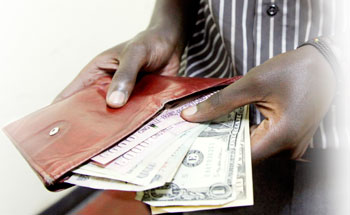The National Bank of Rwanda (BNR) is set to face a tight battle against rising inflation, which reached 7.52 per cent last month up from 0.23 per cent in December last year. Although Rwanda has the lowest inflation rate in the region, economists warned that the central bank needs to usher-in new measures, particularly by tightening the monetary policy to check the stubbornly rising prices of goods and services


The National Bank of Rwanda (BNR) is set to face a tight battle against rising inflation, which reached 7.52 per cent last month up from 0.23 per cent in December last year.
Although Rwanda has the lowest inflation rate in the region, economists warned that the central bank needs to usher-in new measures, particularly by tightening the monetary policy to check the stubbornly rising prices of goods and services
Figures from the National Institute of Statistics of Rwanda (NISR) show that the high inflation rate which was experienced last month is due to the increasing cost of housing, water, electricity, gas and other fuels.
Information from Energy, Water and Sanitation Authority (EWASA) shows a considerable rise in prices of water and electricity since 2005 due to the increased cost of production.
"The cost of chemicals and infrastructure maintenance has been going up in the recent past, this has been a major cause for the increased water prices per cubic metre,” EWASA’s Marketing Manager, Felix Gatanazi, told Business Times.
Gatanazi explained that water is priced in usage intervals and the more cubic metres a client consumes, the more they pay.
"From 0-5 cubic metres, a clients is now paying Rwf240 from Rwf200 six years ago, from 21-50 a client pays Rwf400 per cubic metres and from a range 101-500 a client pays Rwf740. But we advise clients to use as little cubic metres as possible,” he added.
Gatanazi further explained that the increasing electricity charges is due to high fuel prices which is used in generators that provide power to the public.
The country produces 80 megawatts of which 20 are generated by generators.
"The cost of fuel has been increasing on the international market pushing for increased local fuel prices. But we expect prices to go down when the use of methane gas is introduced,” Gatanazi says.
Rwanda being an import dependent economy, experts say, prices of finished goods are expected to shoot up in the coming months occasioned by a volatile global economy.
"All finished goods are likely to go-up because of the increasing cost of production and imported inflation, so the central bank has to come-in and tighten the monetary policy,” Sanjeev Anand, the Managing Director of Rwanda Commercial Bank’s (BCR) told Business Times in an interview.
Rwanda imports most of its finished goods from Europe, Asia and the EAC region, where inflation is in double digits.
"The figures are pushed by the increased cost of production, food items, and the government has already taken measures to curb the figure in a single digit,” central bank Vice Governor, Monique Nsanzabaganwa said.
She explained that the increasing inflation rate is mainly due to imported inflation, although despite the turbulent global economic situation she does not expect the figure to go up next month.
"We have managed to keep the figure in a single digit compared to the region,” she said, adding that government has already taken measures by reducing taxes on fuel.
According to the Managing Director of KCB Rwanda, Maurice K. Toroitich, high inflation will lower the purchasing power among the public, leading to low consumption.
Toroitich explained that on the production basis, inflation will mean high cost of production as producers incur losses due increased expenses.
"For banks, we worry a lot because high inflation means high interest rates and high interest rates mean lower loans applied by our clients yet it’s the way banks make money.”
Economists argue that in order to curb inflation, fiscal and monetary official need to rollout proper monetary, fiscal and financial systems that are efficient and also allow the market to operate on itself to get a balance between demand and supply.


